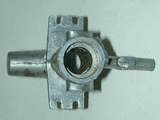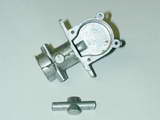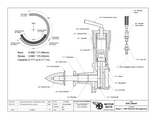The AHC "Black Magic" FRV
Click on images for larger picture
What do you do with a Drunken Sailor?
Or in this case, a Droopy Venturi? While building our individual AHC diesel examples, the Motor Boys came to a number of conclusions regarding why AHC may have abandoned the project. These were collected and turned into an insightful article by Roger Schroeder for his Engine-uity column in the Engine Collectors' Journal [1]. One of the observations was the number of crankcase castings that were unusable due a variety of reasons. A common fault was cases that had been removed from the die so hot that the venturi warped badly out of line when it cooled. The crankcase in the photo here illustrates the problem. We assume that there may have been depths of crudeness to which even AHC would not descend.
Not to stretch the folk allegories too far, if thy Venturi offends thee, cut it off! The bend is at the junction of the venturi and the case proper, either due to differential cooling, or careless handling. Even so, the drilling jig shown in the construction pages would still produce a workable result. But the negative aesthetic impact would be too much to live with, so off it comes. The resulting case could then become a RRV Red Racer variant, but there is another, simpler possibility: drill a hole in the main journal and glue the cut-off bit in to form a Front Rotary Valve (FRV) engine. This results in an engine that is easier to make than the Red Rover, plus inducting the fuel this way will increase the lubrication reaching the front journal, so the engine may even gain a rpm, or two.
Updraft
 The orientation of the venturi in relation to the cylinder does not matter a lot. We might term the common orientation where both are on the same side of the crankcase as down-draft since the fuel-air mix is sucked down into the venturi of an engine mounted with the cylinder upright. But when mounted inverted, such an orientation must suck up into the engine. We know that engines run like this quite happily, so why not place the venturi on the bottom so we have an up-draft for upright mounting and a down-draft for inverted mounting? While this makes for bit of a conversation piece, there is a practical reason as well. If placed in the conventional location, the needle valve would be in line with the mounting lugs due to their high-slung position. This would make the needle hard to adjust. Yup, down below is where it's gotta go.
The orientation of the venturi in relation to the cylinder does not matter a lot. We might term the common orientation where both are on the same side of the crankcase as down-draft since the fuel-air mix is sucked down into the venturi of an engine mounted with the cylinder upright. But when mounted inverted, such an orientation must suck up into the engine. We know that engines run like this quite happily, so why not place the venturi on the bottom so we have an up-draft for upright mounting and a down-draft for inverted mounting? While this makes for bit of a conversation piece, there is a practical reason as well. If placed in the conventional location, the needle valve would be in line with the mounting lugs due to their high-slung position. This would make the needle hard to adjust. Yup, down below is where it's gotta go.
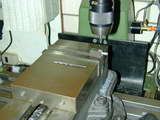 A preliminary CAD drawing was made to check out clearances etc, then the detached venturi drilled and tapped in the usual jig. Next, the case was drilled 1/4" to a depth that penetrates into where the shaft bushing bore will eventually be and the stub glued in with high temperature Locktite. For added insurance, the narrow space between the venturi and the case was filled with a metal filled-epoxy product (similar to "JB-Weld").
A preliminary CAD drawing was made to check out clearances etc, then the detached venturi drilled and tapped in the usual jig. Next, the case was drilled 1/4" to a depth that penetrates into where the shaft bushing bore will eventually be and the stub glued in with high temperature Locktite. For added insurance, the narrow space between the venturi and the case was filled with a metal filled-epoxy product (similar to "JB-Weld").
 The final step before machining was to sand blast the case. The result is a stove-pipe look that could almost pass for "as cast" if you didn't know that AHC diesel cases did not look like this at all. Also visible in this shot is another common casting flaw. Notice how the metal has not fully flowed into the exhaust stack on the right of the photo creating an unsightly cosmetic defect. No way could this case be used commercially, and there are a lot of cases with flaws like these.
The final step before machining was to sand blast the case. The result is a stove-pipe look that could almost pass for "as cast" if you didn't know that AHC diesel cases did not look like this at all. Also visible in this shot is another common casting flaw. Notice how the metal has not fully flowed into the exhaust stack on the right of the photo creating an unsightly cosmetic defect. No way could this case be used commercially, and there are a lot of cases with flaws like these.
Machining of the case was completed as described in the Prototype and production pages. The only difference being that after gluing in the shaft bushing, the hole already jig-drilled in the venturi needed to be carried on through the bushing. The inlet diameter arrived at for the side port version (0.140" or #28 drill) was retained so that a comparison of performance could be made.
Crankshaft Modification
Now we come to the burning question of what timing to use? Common practice for FRV model engines is to open the inlet about the time that the transfer closes (yes, there are exceptions). For the AHC, this is about 57° after bottom dead center (ABDC). Inertia of the gas flow in the inlet allows us to continue induction after top dead center. But the AHC is a rather slow revving engine meaning that the flow velocity will not be high, so to avoid the possibility of blow-back, it was decided to close at 15° after top dead center (ATDC). Allowing a degree or so between transfer closing and inlet opening gives a total inlet duration of 136°; not all that much more than the 110° provided by the side-port version, but skewed to where it will do the most good.
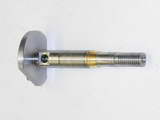 With a longer inlet period, the mass of fuel-air inducted should be greater, resulting in a higher mean effective pressure (MEP) when burnt. This, in turn, should result in more power, translating into higher rpm for a given load (prop). Unless, that is, the gain is short-circuited by some other inherent limitation of the AHC design moving to center stage. We won't know until the fat lady sings.
With a longer inlet period, the mass of fuel-air inducted should be greater, resulting in a higher mean effective pressure (MEP) when burnt. This, in turn, should result in more power, translating into higher rpm for a given load (prop). Unless, that is, the gain is short-circuited by some other inherent limitation of the AHC design moving to center stage. We won't know until the fat lady sings.
Now where to place the hole in the crankshaft to achieve the desired timing. This is a very simple CAD exercise, or a slightly more difficult pencil and paper one. See Model Engine World for just how complicated it can be made[2]! As the process can be applied to all sorts of model engine projects, not just the AHC, a special How-to page for FRV timing has been created that details the steps and some of the theory behind the process.
See How They Run
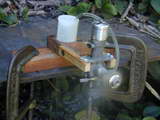 The updraft started second flick, honest! Stan Pilgrim would say this means that the piston was fitted *way* too loose and I tend to agree. A cast-iron piston in a steel liner with TDC "pinch" should start off tight. This one just wanted to scream. Even with the 10x6 APC break-in prop seen here, it was turning over 7000+ rpm, rich, and with the compression backed off. There was no trouble choking the updraft venturi and no problem with "siphoning" while stopped. So after five minutes of minor annoyance to the neighbours, the prop was changed to the standard 8x4 APC used on the previous AHC diesels.
The updraft started second flick, honest! Stan Pilgrim would say this means that the piston was fitted *way* too loose and I tend to agree. A cast-iron piston in a steel liner with TDC "pinch" should start off tight. This one just wanted to scream. Even with the 10x6 APC break-in prop seen here, it was turning over 7000+ rpm, rich, and with the compression backed off. There was no trouble choking the updraft venturi and no problem with "siphoning" while stopped. So after five minutes of minor annoyance to the neighbours, the prop was changed to the standard 8x4 APC used on the previous AHC diesels.
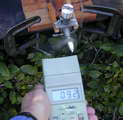 After restarting and screwing the comp down to even out the running on the smaller prop, the needle was leaned and the damn thing settled down to a steady 8,800 rpm! Now steady is a relative term. At 8,800, the thing was vibrating like a front-load washing machine spin drying a load of beach towels. We are talking serious vibration. And noise. As vibration was affecting fuel feed in the rather long fuel line, the test mount was modified for more rigidity. This stopped the fuel foaming and, as can be seen here, the AHC delivered a steady 9,200 rpm. After another five minutes of this, I packed up, feeling guilty over all the racket the AHC had made. How times change...
After restarting and screwing the comp down to even out the running on the smaller prop, the needle was leaned and the damn thing settled down to a steady 8,800 rpm! Now steady is a relative term. At 8,800, the thing was vibrating like a front-load washing machine spin drying a load of beach towels. We are talking serious vibration. And noise. As vibration was affecting fuel feed in the rather long fuel line, the test mount was modified for more rigidity. This stopped the fuel foaming and, as can be seen here, the AHC delivered a steady 9,200 rpm. After another five minutes of this, I packed up, feeling guilty over all the racket the AHC had made. How times change...
Conclusions
There is now absolutely no doubt that, as observed by Bert Streigler in his evaluation of the Red Racer AHC, what looks like a rather constricted transfer passage in no way limits the potential performance of the basic design. The fact that the Black Magic version turns faster with less inlet duration than the RRV suggests to me that shaft lubrication is a factor which is assisted by a front rotary valve. But on the strength of a few examples only, you can't really make any definitive statements. The AHC is still a flawed design. But then, all single cylinder two-strokes are a collection of compromises. As soon as one impediment to performance is neutralized, another takes center court. In the case of the AHC, we have proven that the first limitation is the side-port inlet duration. Both the RRV and FRV easily pass the 7,300 rpm offered by the best of the side-ports. The next limit seems to be shaft lubrication. The RRV was timed for 175° of inlet duration, yet the FRV easily tops it by at least 900 rpm with an inlet duration of only 138°. All the AHC versions run hot. Using instrumentation of dubious accuracy—ie, carefully calibrated burnt pinkies—it feels like the journal gets as hot as the head. The FRV reduces this and moves the pointer to the next problem area: this sucker is very badly balanced.
The AHC is still a flawed design. But then, all single cylinder two-strokes are a collection of compromises. As soon as one impediment to performance is neutralized, another takes center court. In the case of the AHC, we have proven that the first limitation is the side-port inlet duration. Both the RRV and FRV easily pass the 7,300 rpm offered by the best of the side-ports. The next limit seems to be shaft lubrication. The RRV was timed for 175° of inlet duration, yet the FRV easily tops it by at least 900 rpm with an inlet duration of only 138°. All the AHC versions run hot. Using instrumentation of dubious accuracy—ie, carefully calibrated burnt pinkies—it feels like the journal gets as hot as the head. The FRV reduces this and moves the pointer to the next problem area: this sucker is very badly balanced.
Improving the balance would be rather difficult. The shaft web is only 1/8" thick and already cut away to the max in order to provide some illusion of counter balance. Thickening it is not really practical due to the geometry. It appears that the FRV version represents the peak of performance for the AHC. Careful attention to propeller balance might reduce the vibration and add a few rpm, but over 9K rpm from such a long stroke engine is nothing to sneeze at. I'm calling the Black Magic a success and will probably make some more of them.
The APS New Black Widow is for 2cc up engines, mounted inverted, so the AHC Up-draft seemed ideal and the name flowed from that. No way is an AHC powered model going to compete against the folk who are planning to install Taipan 2,5 TBRs, but who cares, it's a fun event and this should be fun. So the easy part is now done—the engine is ready and waiting. The air-frame may take a little longer...
Postscript: why "Black Magic"?
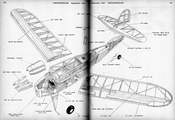 Well, the compression screw is black-ish... Actually, it stems from a "one model" free-flight competition held locally each year. A vintage or classic design is chosen, plans with laser-cut parts made available, and everyone has a fun time. For 2007, the model chosen was the APS (Aeromodeller Plan Service) "Black Magic". This is a 60" cabin design by Fred Hempsall that originally appeared in September, 1947 for spark-ignition engines. It was updated slightly for diesel power and radio control as the New Black Magic in August 1956 by one A Garman. Now everyone knows that real radio control is rudder-only with vacuum tubes, A & B batteries, rubber driven escapements, etc
Well, the compression screw is black-ish... Actually, it stems from a "one model" free-flight competition held locally each year. A vintage or classic design is chosen, plans with laser-cut parts made available, and everyone has a fun time. For 2007, the model chosen was the APS (Aeromodeller Plan Service) "Black Magic". This is a 60" cabin design by Fred Hempsall that originally appeared in September, 1947 for spark-ignition engines. It was updated slightly for diesel power and radio control as the New Black Magic in August 1956 by one A Garman. Now everyone knows that real radio control is rudder-only with vacuum tubes, A & B batteries, rubber driven escapements, etc  , or as we used to say back then, free-flight with occasional radio interference: "Radio, si. Control, no...". Maybe we could fit a servo to drive the rudder via a torque rod, escapement-style, and actuate it with push buttons wired to give bang-bang operation (all rudder deflection, or no rudder deflection).
, or as we used to say back then, free-flight with occasional radio interference: "Radio, si. Control, no...". Maybe we could fit a servo to drive the rudder via a torque rod, escapement-style, and actuate it with push buttons wired to give bang-bang operation (all rudder deflection, or no rudder deflection).
References
![]()
Please submit all questions and comments to [email protected]
